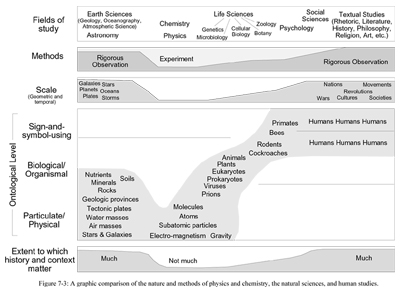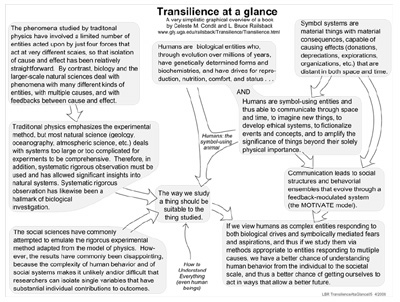Transilience, in pictures
to access a larger version of that image.
Biological being, in contrast, is a mode in which there are circuits of causality with rheostatic feedbacks, and where experiments are less useful because single causes with single effects are rare. The nature of biological entities depends on historical context as the result of biological evolution: there is variance through time. Most importantly, biological entities are more than the sum of their physical matter, in that atoms are configured by life to yield a self-sustenance and reproduction beyond that of physical being. This linkage of systems and emergence of properties is represented by the middle island in the illustration at right, and the historical nature of biology is represented by the stratigraphic layers of past life.
Symbolic being, the world of words, images, and ideas inhabited by symbol-users like humans, has dynamics beyond those of physical and biological being. Here, symbol-users take knowledge and ideas from across the world or the distant past, recast those symbolically-conveyed concepts to meet their own needs, and use them to shape behaviors and structures from the personal to the international scale. The uppermost island represents this mode of being, where symbols flow between people of the present and from people of the past, and where symbolically mediated concepts lead to institutions and creations. The space shuttle at the culmination of the illustration is a great example: a transilient phenomenon incorporating mechanical, cyber, and human components to carry out a mission to fulfill aspirations no symbol-less being could envision, inspired the symbolic creations of science-fiction writers, scientists, politicians, and aerospace contractors. It also represents a commitment to the future, a concept of no meaning without symbological mediation.
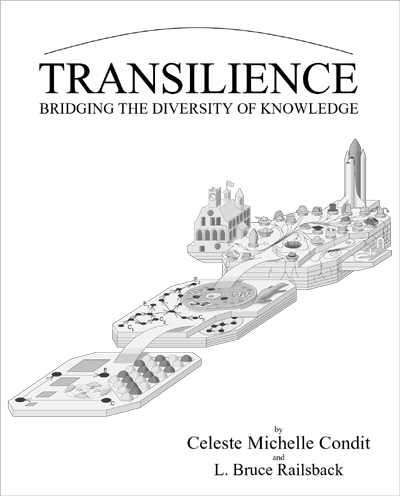
One outgrowth of the study of biological being has been biological determinism, the assumption that human beings respond to stimuli in ways dictated by their biological history and evolutionary experience. Human behavior is thus believed to be highly predictable and explicable, to at least a qualitative degree, because the response of a human to a stimulus or situation is dictated by inherited patterns of behavior. The consilient view of humanity propounded by biologist E.O.Wilson extends that premise further by treating all biological being as simply one form of physical being, wherein determinism at least in theory extends to mathematically exact predictions of events akin to the collisions of billiard balls.
In contrast, the transilient view of human behavior suggests that humans can use their symbol-processing capabilities to envision many responses to a stimulus or situation. Reports of other human's experiences, models of possible outcomes, projection of the effects of one's actions, and consideration of the resultant actions of others are all inputs that a symbol-using being can assess in choosing a response to a stimulus or situation. This is not to say that all humans make such assessments and choices - they commonly respond like non-symbol-using biological beings. In the illustration at right, the white ball represents an otherwise non-stimulated human. It is impacted by the black ball, which represents some stimulus. Physics predicts only one possible response for the white ball - to strike the red ball. Biological determinism likewise predicts only one possible response for the human that the white ball represents - to strike whatever the red ball represents. One goal of transilience is to encourage the human to choose a potentially positive response (one of the yellow, purple, and blue balls) rather than an unthinking physical or biological response represented by the path to the red ball. Such a model requires thought before action - but symbologically mediated thought should be a characteristic of intelligent beings who have progressed beyond the level of only physical and biological being.

One concept critical to transilience is that of interaction, as opposed to combination or compromise. Two phenomena can come together to make something combining the characteristics of both, or compromising between those characteristics. In the very simple illustration at upper right, two liquids are combined to yield a substance with characteristics (color in this case) that compromise between the two. Interaction instead implies that the two phenomena come together to produce something with characteristics beyond those of either individually. In the illustration at lower right, interaction rather than compromise leads to an unexpected color and a dynamic nature.
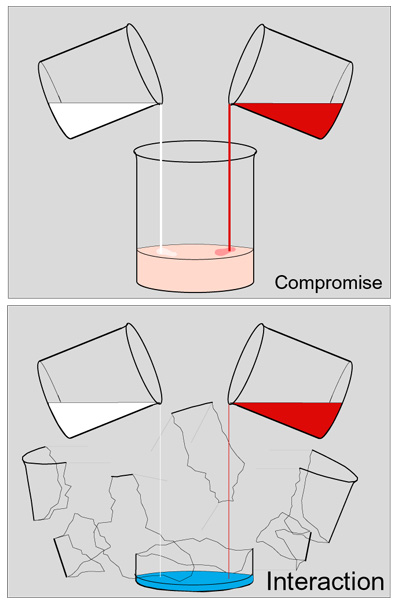
In the transilient understanding of human behavior, interactions of biological drives with symbolically mediated behavior lead to remarkable results. For an individual example, consider how the biological need of humans for personal shelter and primate status drives combine with symbolism to lead to closets of designer clothing, monogrammed shirts, school ties, power suits, and uncomfortable shoes. It's far more than what a hairless primate needs to keep warm, and far more than a purely symbolically calculating being would determine to be necessary to contain body heat. For a cultural example, consider how biological drives for novelty and status combine with symbolic means to indicate or record the nature of sounds to give a breadth of music that as yet expands in diversity, if not necessarily in quality, to a seemingly endless extent beyond what any one human could listen to. It has progressed far beyond primates cooing and humming to their babies, and it commonly expresses drives that a purely symbological rationalizer would find perplexing, if not embarassing. At the global scale, consider the example of humans exhibiting the status drives common among primates, where standing erect, howling, and beating one's chest indicate dominance, but now combined with the symbolically mediated concepts of authority, statehood, and chain-of-command, and the symbolically mediated capability to produce powerful weapons and command-and-control over great distances. In this case, biological and symbology can combine to create vast states and/or lead to the deaths of thousands if not millions of people, and to the destruction of both cities and the natural environment. In this case, exemplified by countless despots, interaction via amplification takes matters far beyond the biological status drive of a chest-thumping primate or the symbolic capability to communicate a command.
The illustration at right attempts to capture this concept of interactions between biology and symbology, represented by strings of DNA and strings of symbols, to produce results beyond the scope of each. For example, a symbolically mediated understanding of metallurgy and engineering can interact with biologically drives for food, status, and novelty to produce a scythe to harvest grain, a tank with which to invade or dominate, or a piano for the making of music. They can combine to produce a medal awarded for bravery in war, or a medal awarded for promoting peace. They can combine to produce a radio antenna with which to monitor the communications of one's fellow citizens, or a radio antenna with which to search for signals from beings beyond our solar system. Imagine a world in which we recognize the power of these interactions and in which actively we choose those interactions that promote peace and well-being.
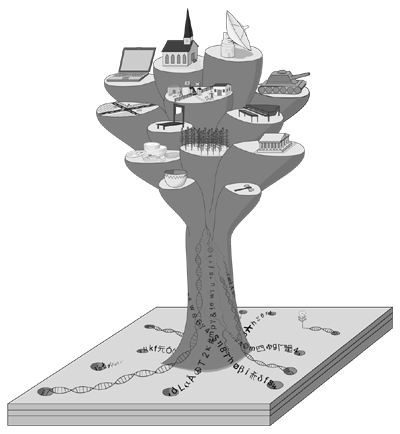
The diagram at the right is a flowchart outlining how the environment, biology, and symbol-use combine to produce social behaviors. As an illustration, let's assume you just noticed that four children are trapped in a burning home near yours (that's the environment). To use the terms of theorists of language, environmental conditions are transmitted to individuals via direct contact (e.g., the pain of a burn injury), indexes (the sight of another person's wound), signs (the cries of pain from a injured friend), and symbols (the spoken report of pain of an injury). Those inputs are subjected to interactions of biology and symbology, such as channeling (e.g., "I should risk injury for the good of my community" or alternatively "Someone else is better trained for this situation"). Another kind of interaction of biology and symbology is amplification ("If I risk injury for the sake of the tribe, I will receive a medal" or "I should flee because my tribe needs my special abilities in other areas"). Yet another is fictionalization ("If I die in the effort for my tribe, I will go on to another existence in which I will watch sports and eat dark chocolate forever" or "I think I hear the fire truck coming, so I shouldn't get in the way"). Fictionalizations can also be more metaphysical, and in some cultures they might include "Fire is the physical embodiment of the positive power of the universe" or alternatively "Fire is the visible manifestation of all that is evil".
As we move from the left side of the diagram to the right, the possible results of these interactions (not compromises, but interactions) are behaviors. They might include dashing into a burning house, running from a fire, shouting epithets at the fire, summoning help, or just standing and watching. With repetition over time, these behaviors establish social structures (e.g., neighborhood loyalties, volunteer or professional fire departments, citizen-of-the-year-awards, 9-1-1 phone systems, insurance companies, orphanages, etc.). They thereby lead to behavioral ensembles (in our example, patterns of community cooperation or, alternatively, alienation and societal dysfunction). Feedbacks from these behaviors and social structures include modification of the original environmental conditions (fire codes) and learned predisposition and reinforcement of some of the original behaviors (first-aid classes, and training in rescue techniques). The feedbacks can even involve evolution via selection of biological predisposition for certain behaviors (greater reproductive success for those of us prone to actions considered heroic or, alternatively, elimination from the gene pool of those of us who can't recognize an intractable situation).
Symbol-use and language also create the capacity for moral judgment. Through them, we assign evaluative terms such as "good" and "bad" to configurations of matter that carry no moral value in the world of experimental science. As we ponder what to do about the four children imperiled by the flames, physics and chemistry inform us that there is nothing innately "bad" about carbon dioxide and water vapor or "good" about molecules of multiple carbon atoms bathed in aqueous solution. In fact, carbon dioxide would be the equilibrium condition of carbon in our oxygen-rich atmosphere and thus seemingly the more philosophically satisfying state. Evolutionary biology similarly tells us that we have no motivation to save those four children, so long as they are no kin of ours, and that we would be foolish to risk our lives, our reproductive capability, or our capability to support our offspring in any effort to rescue those children. Any explanation of what we should do in response to the emergency next door, and any prediction of what someone else will do, is not understood well through physics or biology alone. The response of a symbol-using being is better understood in terms of a symbolically mediated process where behaviors are assigned non-physical and non-biological moral designations like "good" and "bad", "brave" and "cowardly", or "noble" and "callous".
If the Transilient model moves beyond a purely biological explanation of human behavior and thus dismays consilient biologists, it also frustrates anti-consilient thinkers who venerate the power of words and ideals. Those folks can be found among humanists on the left who hold that every thing is constructed entirely and only by language - that, in the words of the deconstructivist Jacques Derrida, it's "language all the way down". They're also found on the right, where the human body is believed to be only a physical empowerment, or impediment, of an ethereal human spirit. However, neither denial of the reality of fire nor declaration of spiritual superiority over fire will long sustain the human behavior of walking through roaring flames.
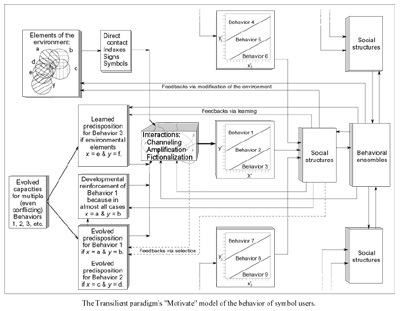
As noted above, Transilience is a new perspective on knowledge, and its name is a bit of a play on "Consilience". One concept useful to understand this new perspective is Transplexity, likewise an obvious play on "complexity". If complexity is what arises when things are arranged in configurations beyond the properties of the things themselves, transplexity is what arises when things of multiple types arrange themselves so as to maintain functionality and to self-perpetuate, and to change into new configurations. The table at right outlines some the key differences.
Consider the sedimentological example of sand on the sea floor. The sand consists of individual more-or-less round grains. The motion of waves can nonetheless move the sand into ripples on the sea floor, and the position of any ripple can then modify the motion of the waves to influence the position of other ripples. Thus both ripples themselves, and the larger-scale arrangement and spacing of multiple ripples, arise. That would be an example of complexity arising where there initially was none. However, the process is limited - with no more sand, the ripples cannot generate more ripples. Furthermore, it is not self-perpetuating - if the waves subside and organisms disrupt the ripples, the ripples do not respond so as to restore or repair themselves, or to achieve a new and different configuration.
By contrast, consider the transplex example of an institution, which consists of multiple kinds of components (humans, furniture, buildings, data-storage devices, and computers, at the very least). The institution takes in resources and thus maintains itself while it transforms those resources into something else. The institution sustains itself during times of duress, perhaps seeking out new resources as previous ones become scarce or as new ones become available. The institution can choose to turn itself into something different if it sees fit - a political party can become a terrorist organization, or vice versa. These capabilities exemplify the difference between complexity and transplexity.
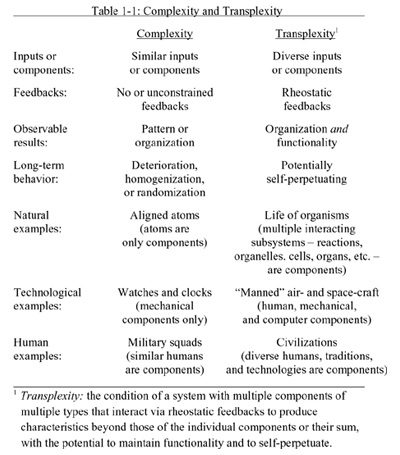
Use of the concept of transplexity lets one put phenomena to be studied in a new perspective, as the diagram at right shows. Each sphere represents a phenomenon that humans study. Each is positioned according to whether its behavior is time invariant or alternatively dependent on historical context. Thus things studied by physics and chemistry fall toward the front of the diagram, and things studied by the natural sciences (e.g., geology or oceanography) and social sciences fall further back in the diagram. Complexity is scaled from left to right, so that phenomena that can be meaningfully studied as single entities fall to the left and those whose arrangement must be considered fall to the right. Finally, transplexity is scaled from bottom to top. The spheres collectively follow a path something like a climbing "S", from fundamental particles to global communication.
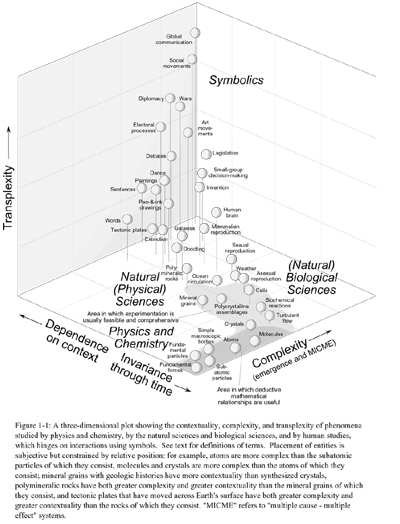
As noted above, Transilience distinguishes between the physical mode of being, in which experimentation works well, and the biological mode of being, where feedbacks make one-cause - one-effect experiments less useful, and ultimately symbolic being, where flows through time and space commonly make experimentation unfeasible. An important concept within Transilience is that the method used to study a thing should be appropriate to that thing. If a system involves single causes that lead to single effects, if its forces operate at different scales, and if there are relatively few types of things to be studied, the experimental method is appropriate. That has certainly been the case in traditional physics. However, the more natural sciences - geology, oceanography, and meteorology, for example - study systems in which scale and interlinkage of causes and effects make rigorous observation (careful collection of observations through time and space) a more effect method. The same is commonly true in the study of biological being. The diagram at right illustrates that generalizations about the natural sciences (again, the sciences of nature, as opposed to physics and chemistry) are also commonly applicable to the studies of human texts and institutions. Neither a government, a social movement, a storm system, nor a tectonic plate are ready subjects for experimentation, but a useful, replicable, and falsifiable understanding of each can be gained by rigorous observation. To use the terminology above, increasingly transplex phenomena are increasingly more effectively studied via rigorous observation than by experimentation.
